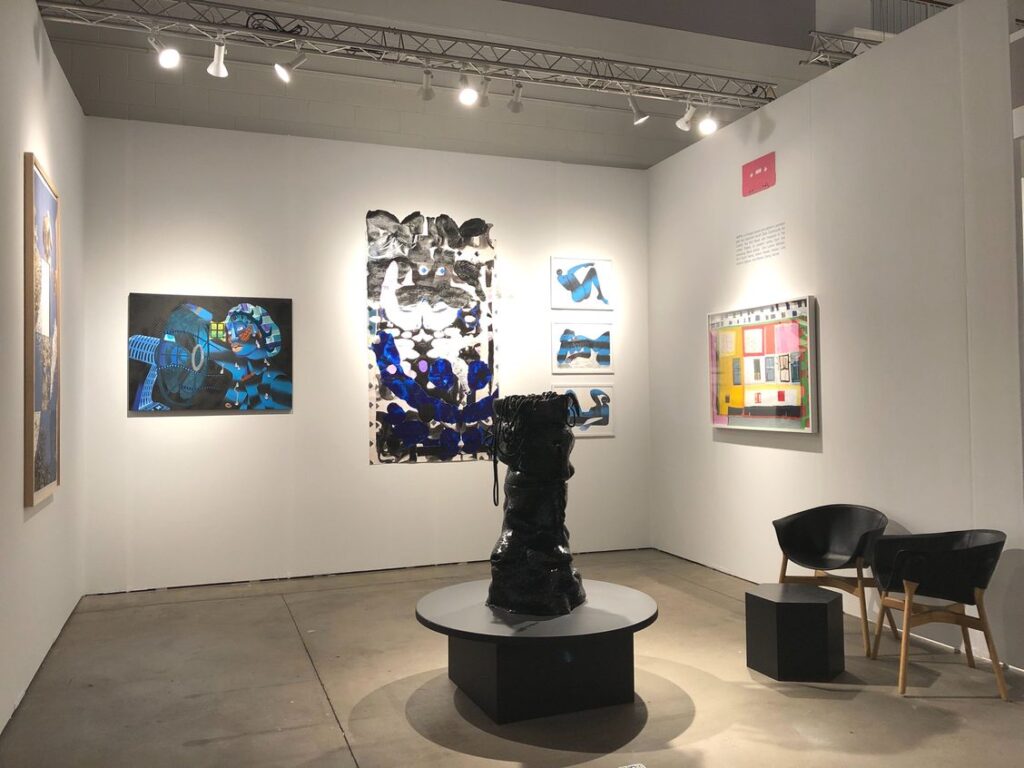AMFM, a Chicago based arts platform, partners with the historical South Side Community Art Center, the first Black arts museum in the United States, to present works from emerging Black artists, Erin LeAnn Mitchell, Erol Scott Harris, Kelvin Kweku Haizel, Lola Ayisha Ogbara, and Modou Dieng Yacine. Mitchell, Harris, Haizel, Ogbara, and Yacine explore the domestics of home, time, architecture, and interiority through the use of the body and figure in their work through abstraction, sculpture, painting, and textile.
Check out our Booth Showcase here.
Harris inserts his body within his work by dipping body parts in paint, and using himself as a mark making tool, resulting in pieces that resemble the Rorschach Inkblot Test. His methodical and deliberate approach to painting also involves using unconventional objects and materials such as mops and hair, to create strokes on a linoleum flooring, which he uses as his canvas. The linoleum is a reference to his grandfather’s migrant labor experience. Harris’ work defies the confines of space. At times the canvas spills out onto the floor and creates new forms on the wall outside of the rigidity of a traditional canvas and painting styles.
Mitchell’s work oscillates between time and space through the historical references that influence her work, and contemporary Afro-futurism. She uses traditional Southern craft methods of pattern making and quilting to root her practice and make a commentary on the Black femme and the domestic labor of women. The textures and ornamental designs used within her pieces are as much a part of the story of the work, sometimes referencing ancient symbolism, layered beneath images that at times make a social commentary on the past, present and future of the female form. Her futuristic figures at times appear alien and androgynous to speak to the expansive nature of the Black body and a future that operates without bounds.
Haizel transforms what we know photography to be and changes the way the viewer sees the image through his manipulation of the medium. From rearranging and re-orienting the frame in what he calls a puzzle game, to omission, and even scratching at the surface of the photo, to examine illegibility as it relates to the Diaspora and the photographic medium. During his residency in Chicago in 2022, Haizel stripped himself down to just his camera and took tourist snapshots of Black Chicago life, from street scenes of people and train rides, to candid and staged photos to create an entirely new body of work outside of his large scale installations. Inspired by the writings of Tina Campt, Haizel is interested in the dismantling of the white gaze and obscuring the ways the Black image and humanity is seen, which is why in the images he produces, he uses an X-Acto knife to scrape away any resemblance of skin color.
Ogbara’s sculptural work explores power structures through her body-like sculptural figures that both present form and formlessness. Inspired by the Black female forms of her own body and figures of bodies not often represented in the mainstream, these matriarchal figures appear as sensual and fluid clay bodies. Ogbara works intuitively, and at times adorns her work with accessories or materials meant to mimic earrings, hair, and acrylic nails, and evoke a child-like playfulness and sometimes sensuality. The work is also displayed with objects related to the interior spaces like rugs, wooden stools, and other objects that can be found within Black domestic spaces.
Yacine’s work lies at the intersection of his multi-layered identity. Having grown up in a small French Colonial settlement in Senegal where he attended a French Catholic school, and later moving to the more urban and artistic capital, Dakar, his image of Blackness and his own self actualization shifted the trajectory of his work. Oftentimes inspired by street and pop art in its vibrancy, use of repetition, and mark making, Yacine is also exploring themes of the Bauhaus era in the way he deconstructs and abstracts the exteriors of buildings that he grew up seeing in as a youth juxtaposed at times against Senegalese and Black historical figures, diplomats, layered alongside pop cultural ephemera, or materials found on the streets of Africa. He is interested in exploring belonging, Black identity, and negritude.

COMMENTS ARE OFF THIS POST